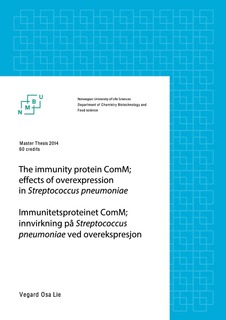| dc.description.abstract | Streptococcus pneumoniae is an opportunistic Gram-positive bacterium that resides in the upper respiratory tracts of humans and can be responsible for fatal diseases such as pneumonia, bacteraemia, meningitis, and endocarditis. Pneumococci are capable of natural transformation, allowing them to quickly adapt to environmental change. This makes pneumococcal infections challenging to treat as they can acquire new phenotypes by incorporating foreign DNA by homologous recombination. This state of competence is induced by a peptide pheromone called CSP-1, which is sensed by a quorum sensing mechanism. During competence, the bacterium secretes a murein hydrolase called CbpD which targets closely related streptococci resulting in lysis and release of DNA. This predatory mechanism is called fratricide, and CbpD is regarded as a fratricine. To avoid self-lysis, the competent cells needs to protect themselves against their own fratricine. This is accomplished by expressing of the immunity protein called ComM. This protein is also produced during competence, albeit at an earlier stage then CbpD, thus giving the cell time to protect itself. ComM is predicted to be an integral membrane protein with immunity focused against CbpD. The mechanism for this is still unknown. The aim of this study was to obtain a deeper understanding of how the immunity protein ComM works through ectopic expression using the ComRS-system while also attempting to determine the location of ComM in the cell. In this work a growth experiment was conducted by ectopically expressing ComM using the ComRS system. This experiment showed morphological changes of the cell shape and an increased resistance towards LytA from the immune cells, which leads to the assumption that ComM is responsible for modification(s) to the cell envelope. To test this hypothesis, reverse phase HPLC analysis of the stem-peptides of immune cells was conducted. The results showed no detectable difference in the stem peptide composition, which could mean that the modification is located elsewhere. Furthermore, zymography experiments showed that cell walls derived from immune (ComM+) cells were more resistant against purified CbpD compared to cell wall derived from sensitive (ComM-) pneumococci. This supports the notion that ComM somehow induces changes in the cell envelope that provide protection against CbpD. This showed that the CHAP domain is catalytically inactive without its cell wall binding domains (two SH3b domains and a choline binding domain). Also part of this work was an attempt to localize ComM in immune cells with the use of the fusion protein sfGFP-ComM. Since CbpD has been shown to target the septal region of target cells it has been speculated that ComM is located in the septum. This localization studies in this work, however, did not lead to any conclusive data. | nb_NO |

